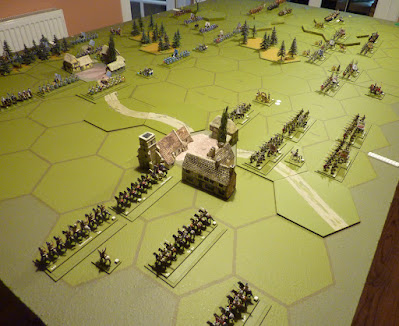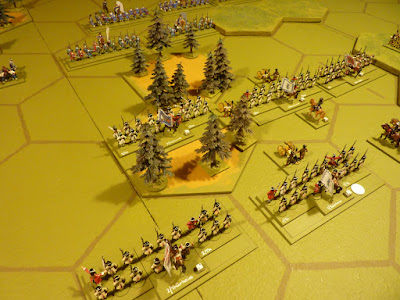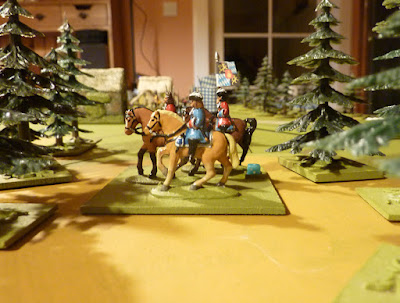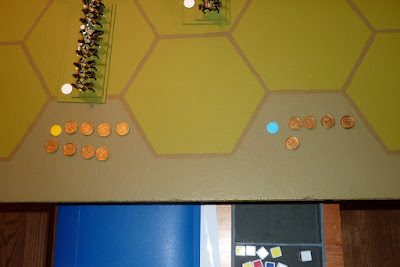Yesterday (Thursday) I hosted this little-known action; a post from last week included some pictures of the initial set-up. My Zoom opponent was David, and we used my Corporal John rules, of which David has had some limited experience previously.
Scene-setting photo shows part of the Austrian left wing; General Backer (a Lorrainer) in command of his brigade, just outside the village of Sankt Roman
Background - Briefing Note and OOB
Following the defection of the Elector of Bavaria to the
side of the French king, the Holy Roman Emperor orders that attacks be made on
Bavaria right at the start of 1703, to inflict punitive damage and to make it
clear what repercussions might be expected.
Feldmarschal Leopold Anton von Schlick has been sent to
seize control of crossings over the Danube and the Inn in the area around
Passau. The Bavarians know all about this expedition, and the Elector leads a
strong force to contest the area. The two armies more or less blunder into each
other near Schärding.
The two commanders are regarded as being competent, and the
forces are roughly equal. In Corporal John terms, the commanders each
have a hand of 5 Command Cards, and an initial allocation of 3 Combat Cards.
Capture of either of the villages of Sankt Roman and Shießdorf will result in 1
temporary Victory Point [this means that an army entering a village which it
does not already hold will gain 1VP, and will be regarded as holding that
village until the enemy enters it – it is not necessary to leave a defending
force in the village – if a village changes hands, the temporary VP will be
transferred across]. 8 VPs wins the day.
The forces are of very similar make-up – the Bavarians have
1 extra unit of foot, the Imperialists 1 extra unit of horse. Neither army is
trained in platoon fire. The Bavarians have two elite units (Leibgarde and
Leibgrenadiere), and three of the Austrian foot units have attached battalion
guns.
Position at 8am is shown on the map. David chose to be the Elector of Bavaria, which meant that I was Feldmarschal Von Schlick for the day, and a dice roll decreed that I would go first.
Bavarian
Army (Elector of Bavaria) (7
horse; 12 foot; 2 art; 5 leaders)
Arco’s
Brigade (Generalmajor Graf d’Arco)
Arco Kürassiere (3 Sqns)
Costa Kürassiere (3 Sqns)
Monasterol Dragoner (3 Sqns)
Santini Dragoner (3 Sqns)
Weichel’s
Brigade (Generalmajor Weichel)
Leibgarde (3 Sqns)(elite)
Weichel Kürassiere (3 Sqns)
Wolframsdorf Kürassiere (3 Sqns)
Brinkelhof’s
Brigade (Generalmajor Brinkelhof)
IR Bettendorf (2 Bns)
IR Haxthausen(2 Bns)
Boismorel Grenadiere (1 Bn)
Leib Grenadiere (1 Bn)(elite)
1 field battery
Maffei’s
Brigade (Generalmajor Marquis de Maffei)
IR Lützelberg (1 Bn)
IR Kurprintz (1 Bn)
IR Maffei (1 Bn)
IR D’Octfort (1 Bn)
IR Spilberg (1 Bn)
IR Tattenbach (1 Bn)
1 field battery
Imperial
Army (Feldmarschal Leopold von Schlick) (8 horse; 11 foot; 2 art; 5 leaders)
Niederhammer’s
Brigade (Generalmajor Niederhammer)
Alt-Hannover Kürassiere (3 Sqns)
Cusani Kürassiere (3 Sqns)
Gronsfeld Kürassiere (3 Sqns)
Aufseß Dragoner (3 Sqns)
Stoltz’s
Brigade (Generalmajor Stolz)
Jung-Darmstadt Kürassiere (3 Sqns)
Lobkowitz Kürassiere (3 Sqns)
Leibregiment zu Pferd (Hessen-Kassel)(3 Sqns)
Spiegel Karabiniere (Hessen-Kassel)(3 Sqns)
Furneburg’s
Brigade (Generalmajor
Furst von Furneburg) [3 units have battalion guns]
IR Alt-Salm (1 Bn)
IR Gschwind (2 Bns)
IR Palffy (1 Bn)
IR Thürheim (2 Bns)
1 field battery
Backer’s
Brigade (Generalmajor Von Backer)
IR Lothringen (3 Bns)
IR Scharfenstein (2 Bns)
1 field battery
A narrative of sorts should emerge from the pictures.
Right at the start, Schlick was concerned about the artillery battery which was exposed on his right, so he ordered up Niederhammer's cavalry brigade to cover the flank - Arco's Bavarian cavalry responded, and brought on a desperate cavalry fight which swung back and forth throughout the day. View is from behind the Bavarian flank
Here you see it from nearer the ground - Arco with the cuirassiers in the foreground
General view of the centre, early in the day, from behind the Elector's lines
The Bavarian right flank, looking towards Schießdorf. Weichel Cuirassiers on the left of the picture, then the elite Leibgarde (in light blue)
Opposite them, the Austrian left surrounds the village of Sankt Roman
Counter-battery fire is rarely very effective in these games, but the Bavarians certainly had the edge on this day - here the Austrian No.2 battery is immediately getting lumps knocked out of it by the Bavarian guns across the valley
General view from behind the Austrian left, around 9:30 - things quiet apart from artillery fire at this end and the mad cavalry scrap in the distance
...as you see - Aufseß dragoons in the right foreground, helping out - it was a feature of the battle that the dragoon units in the cavalry performed pretty well
Bavarian centre, with central heating radiator
Backer still waiting for orders, a situation which lasted most of the day. Unit on the right of the picture is the 3-battalion IR Lothringen, also known as the Bishop of Osnabrück's Guard, which is always welcome on the miniature battlefield because their green uniforms provide a bit of welcome variety [these are ex Eric Knowles troops]
And still the cavalry battle between Arco and Niederhammer continues - red-coated Bavarian dragoons looking a bit exposed here, but they did quite well
Now some helpful cards present themselves, and the Austrian centre pushes forward
The Bavarian Bettendorf regiment has a moment to prepare itself for the onslaught...
...before the Austrian Gschwind lads arrive and punch a hole in the Bavarian line - this looks like a critical moment
[meanwhile] Maffei's Bavarian infantry are undisturbed by the drama to their left...
...and the situation is saved by the Bavarian Leibgrenadiere...
...(here in close-up)...
...and General Brinkelhof, with the Haxthausen regiment, which quickly routed both battalions of Gschwind. Situation stabilized, but some big gaps in the centre now
Still the cavalry on the flank are hard at it, and the Bavarians are showing a lot of damage
Some new spaces in the centre...
In the wood you can see Feldmarschal Schlick in person [please note] bringing forward the Imperial Regiment Thürheim to attack the Bavarian grenadiers
At this point the cavalry fight ended in the Austrians' favour, as Arco was seriously wounded, and the Costa cuirassiers were finally routed from the field. The Victory Points score was now 9-6 to the Austrians, 8 being required for overall victory
Here is a little study of the Bavarian Santini dragoons...
... and the Bavarian Red Grenadiers - the Boismorels - with Lt Col De La Colonie in command, thinking up a positive spin to put on his regiment's performance in his memoirs
The Elector (without hat) begins the job of organising a retreat
Final stand-off in the centre
Close-up of 1st Bn IR Thürheim, complete with their battalion gun. This is another ex-Eric unit, though I supplied the command figures
And the official scoreboard shows 9-6 to the Empire - tell the auditors
Since the scoreboard is not visible through the Zoom cameras, we also have an extra scoreboard on the table. The coloured counters are bonus VPs for holding the villages
My thanks to my worthy opponent - as ever, it was a close game - there were moments in the centre late on when either side could have suffered a major collapse. No problems with the rules, except that the Command Cards allowed us to leave the Bavarian right and the villages pretty much untouched. I forgot to drink my Lucozade, so I must have been busy.
Time to get tidied up - General Backer finally gets the order, late in the evening, to tell his brigade to stand down. It seems that his side won...

































Splendid battle Tony!
ReplyDeleteAlthough I have to say I'd be keeping clear of Scheissdorf myself!
Neil
Thanks Neil :-) don't worry - it's Schießdorf - which I thought meant something like "shoot-town", which is an odd name anyway, but my German friend Julian says it's probably named after some bloke named Herr Schieß - so that's OK.
DeleteTwinned with Lower Widdle I believe.....☺
DeleteNeil
You wascal.
DeleteVery nice to see these lads back on the table Tony - a pretty sight!
ReplyDeleteThanks Ian - it was a nippy little game - the lads send their best wishes.
DeleteThanks very much for the game, Tony. Very enjoyable. Now the Bavarians are looking for revenge in a return match, though. :-) As we agreed, the frustration with Zoom (for the remote player) is not being able to see all the detail of the splendid troops. So, very good to have your report illustrated with your pictures taken during the game... Thanks! :-)
ReplyDeleteMany thanks for taking part, sir, and bravely fought! It has occurred to me that the 1703-4 period lends itself to a little campaign for these two armies, which gives a nice alternative to always fighting the French in the Low Countries (which, itself, is also nice).
DeleteI see you made the Bavarians play with their back to the radiator - I wouldn't want to suggest that you turned it up to put the heat on them but... ;o)
ReplyDeleteDevilish, eh? It was worth a try, anyway. It would discourage them from rushing out into the March weather...
DeleteA fine return to form sir! Is this a made up scenario Tony or a historical one?
ReplyDeleteIt's my usual hybrid - the historical context is correct and viable, but the scenario and the OOBs are just Pretend-Be. In March 1703 there was fighting in the Schärding area for exactly the reasons described in the briefing. Münzkirchen, Sankt Roman and Sch***dorf are/were real villages around Schärding, a little south-east of Passau. One real battle in that historical campaign is recorded in the memoirs of Col De La Colonie (of the Red Grenadiers mentioned above); De La Colonie (who was a Frenchman) says the village was Heyzempirne, which is faithfully reproduced by writers up to and including James Falkner, but this is merely what Colonie's French ears thought they were saying; the village, which still exists today, is Eisenbirn (which I think translates into something like "iron pear"). The battle of Eisenbirn, in March 1703, was fought in deep snow. Our made-up battle of Münzkirchen represents what the forces of Bavaria and the Empire might have been doing on that date and in that region if they hadn't been busy at Eisenbirn (which the Bavarians won, by the way), and if the weather had been rather better.
DeleteIn passing, I now have a few books on the WSS by James Falkner, they are all pretty much the same, I find them heavy going, and as far as I can tell Falkner relies substantially on source books in English, which is what my former acquaintance Peter Gouldesbrough (the wargaming antiquarian) would have described as "a light skim"...
Lovely looking game, very nice to see all those lovely troops on the table, really good.
ReplyDeleteThank you Donnie - it was an enjoyable day - even the technology behaved!
DeleteVery good to see your armies maneuvering across the table. Doubly good to see that you brought "Not By Appointment" David into the fray for a remote game. Have I mentioned lately how much I covet your tote board?
ReplyDeleteThank you Jon - I paced everything steadily - current set up here is that my battlefield scenics are stored upstairs, so I took a couple of evenings to put the table together - must get this sorted out. As I had hoped, no eyesight problems with the toys in the room - different proposition from squinting at a computer screen (which must give me an edge - heh, heh)!
DeleteThe old billiards scoreboard was bought on eBay maybe 8 years ago - it was from an actual billiards hall somewhere in the industrial north of England, pre-WW2 (I think), and my love of it was modified more than somewhat when I discovered it had woodworm and was losing bits - it still has missing bits, but the woodworm are well extinct.
So I love it again.
I agree with previous comments - a fine looking game Tony. Thanks for taking the trouble to report.
ReplyDeleteThank you Jim - maybe a bit of a long-winded read, but I'm having fun! Hope things good with you.
DeleteI received an email from the Professor, in which he said some complimentary things about the battle report [I don't like it - the Professor normally doesn't do sincerity], but also asked what are the bits of white Lego visible at the edge of the table - are they holding the scenery together?
ReplyDeleteWell spotted Prof, but the rather boring explanation is that they highlight the ends of the dotted lines across the battlefield which mark out the flank and centre sectors for the Command Card activation rules. All lifted straight from Command & Colors, but my hand-painted dotted lines don't show up too well via Zoom - especially if there is a village or a road on top of them!
Wonderful looking game Tony. Glorious figures and a fine table. It all seemed to be going along steadily, so I was a little surprised when the Bavarian centre was pierced, but the defeat of their cavalry that should have had the upper hand seemed well below par on their part. Poor troops, poor dice or just the way the casualties mounted? (no pun intended).
ReplyDeleteThanks to Chris for asking about the scenario, as I wondered that myself. I did not notice the 'grid markers', so thanks to the Prof for that one, but was wondering at the 'magic dice' shown in the photo displaying the defeat of d'Arco's cavalry. Are the spots only visible under infrared glasses?! :)
Regards, James
Thank you James. First off, my "Corporal John" game is a heavily edited version of Richard Borg's "Tricorne" boardgame (for the AWI, published by Compass Games), which is itself one of the later nephews of his good old Command & Colors. As such, it uses (customised) decks of cards for activation and for assorted tactical bonuses, and has a set of dice which are not quite the same as those for C&CN.
DeleteIn terms of my CJ Rules, the reason the cavalry battle involving the brigades of Niederhammer and Arco went on for so long (which may seem unlikely) is that both sides made intermittent use of the "Retire and Rally" option which is available when cavalry are attacked - this is effectively what other rules might term an "evade" (though you do not necessarily get away scot-free), so this scrap went on for most of the day, with units falling back when they found themselves outnumbered locally, and returning to the fray when they had sorted themselves out. Casualties here built up fairly gradually, and at one point the Elector also very successfully played a "Rally" card, which removed a couple of casualty markers from the Costa Kürassiere - we assume that Arco made an appropriate motivational speech! Eventually the losses did build up to decisive levels, but it took a while.
The sudden Austrian infantry breakthrough in the centre was triggered by the playing of an "Infantry Rush Into Attack" card (which gives accelerated movement and also some combat advantages), plus some rather lucky dice rolls! The Bavarians did manage to check this advance - the elite grenadiers were useful here - but the central section was weakened. Getting good cards into your hand is gratifying when it happens!
The dice - I should have spent a little time explaining these. The "Tricorne" dice which come with the boxed game are nicely made, but Compass Games will not sell extra sets (in fact they don't even answer requests for them!). Specifically for Zoom-based games, I have thought in the past about manufacturing sets of dice for remote players. It eventually occurred to me that the main clue that players can recognise on the original dice is the colours of the faces, so with blank dice and vinyl sticker patches I have made up a few sets of special CJ Idiot Dice - this works better than you might expect, and is certainly visible on the tabletop through Zoom cameras. I used blue for infantry, yellow for cavalry, red for artillery, silver for "crossed sabres" and white for "retreat flag". [Please note that I can't use standard C&CN dice, because the numbers of faces are different]. The strange photo in my post of the end of General Arco shows two of these home-made "idiot dice" displaying the silver "crossed-sabres" face - which is the classic C&C roll to eliminate a Leader attached to a unit which suffers loss.
I am sure you are probably regretting asking these questions (!) - but thanks very much for them. It is my intention to produce a proper blog post describing a further development of Corporal John which I am working on (with some invaluable help from wise friends). CJ is working nicely as it is, and I shall persist with it with no misgivings, but I also need a variation (CJ Lite? Lance Corporal?) which works for Zoom games and which also copes with multiple players. More of this soon, I hope...